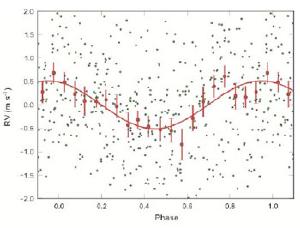Post
Alpha Centauri
has a Posse
17 October 2012
Alpha Centauri is the nearest star to us. (Second nearest if you count the Sun.) It is also a binary system. Those two facts make it instantly appealing to a child with an interest in astronomy. What’s more, the primary star of the system is much like our own sun, so it is easy to imagine an earth-like world orbiting it. Surely it would be a world much like ours, but with two suns in the sky. You almost wish it to be true. I remember rainy summer days when I was about 12, working with a copy of Asimov’s Alpha Centauri to imagine whole solar systems around the two stars.
So when we started looking for extrasolar planets, Alpha Centauri is high on the list of any astronomer’s inner child. But despite its closeness, finding planets there would be difficult. The orbit of Alpha Centauri B is at an angle relative to us, so there isn’t likely to be any transiting planets that we can detect. So that means planets would have to be found by looking at the wobble of the star as the planet orbits it, which is much harder to measure.
 Dumusque, Xavier, et al.
Dumusque, Xavier, et al.In the early days of speculation regarding extrasolar planets, it was thought that double systems weren’t likely to have planets because the two suns would disturb planetary orbits too much. As we developed more sophisticated computer models we found that wasn’t the case. It would even be possible for planets to lie within a habitable zone around either star. But even if they existed, they would still be hard to detect.
Recently, however, we have found one around Alpha Centauri B.1 This planet was found by observing the Doppler shift of the star as it wobbles. Of course B wobbles due to A as well as any planets, so there is a lot of noise in the observations, but if you average the results you get the figure below. The red line represents the best fit curve. If you look at the vertical scale, you find they had to measure Doppler motion at around half a meter per second. That would be like measuring the Doppler shift of someone walking down the street, which is amazing in itself.
The big thing is that we’ve found an earth-sized planet around our nearest neighbor. This planet is only about 10% larger than Earth, but it is very close to the star and its “year” is only 3.2 days long. So don’t plan any vacation trip just yet. But with one planet, there are likely others, and that means Alpha Centauri likely has a solar system.
Which of course makes my inner child squee with joy!
Dumusque, Xavier, et al. “An Earth-mass planet orbiting α Centauri B.” Nature 491.7423 (2012): 207. ↩︎